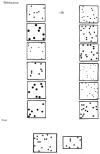Beyond Fast Mapping
- PMID: 21625404
- PMCID: PMC3101498
- DOI: 10.1080/15475441.2010.484379
Beyond Fast Mapping
Abstract
Since the seminal 1957 studies of word learning by Roger Brown, most experimental studies of lexical acquisition have concerned fast mapping: the process through which a new lexical entry is established, and through which representations of the linguistic context of a newly heard word interact with representations of its nonlinguistic context to fix an initial partial meaning. Here I focus on the subsequent extended process through which the adult meaning is approximated. Two factors lead to an extended learning process; the size of the hypothesis space and the need, sometimes, for the creation of new semantic primitives. Sometimes lexical learning requires conceptual change. I sketch a learning mechanism through which this can be achieved. A case study of learning the meanings of verbal numerals illustrates the argument.
Figures



References
-
- Antell S, Keating DP. Perception of numerical invariance in neonates. Child Development. 1983;54:695–701. - PubMed
-
- Baldwin DA. Infants’ ability to consult the speaker for clues to word reference. Journal of Child Language. 1993;20:395–418. - PubMed
-
- Block N. Advertisement for a semantics for psychology. In: French PA, editor. Midwest Studies in Philosophy. Minneapolis: University of Minnesota; 1986. pp. 615–678.
-
- Bloom P. How Children Learn the Meanings of Words. Cambridge, MA: MIT Press; 2000.
-
- Bloom P, Wynn K. Linguistic cues in the acquistion of number words. Journal of Child Language. 1997;24(3):511–533. - PubMed
Grants and funding
LinkOut - more resources
Full Text Sources
